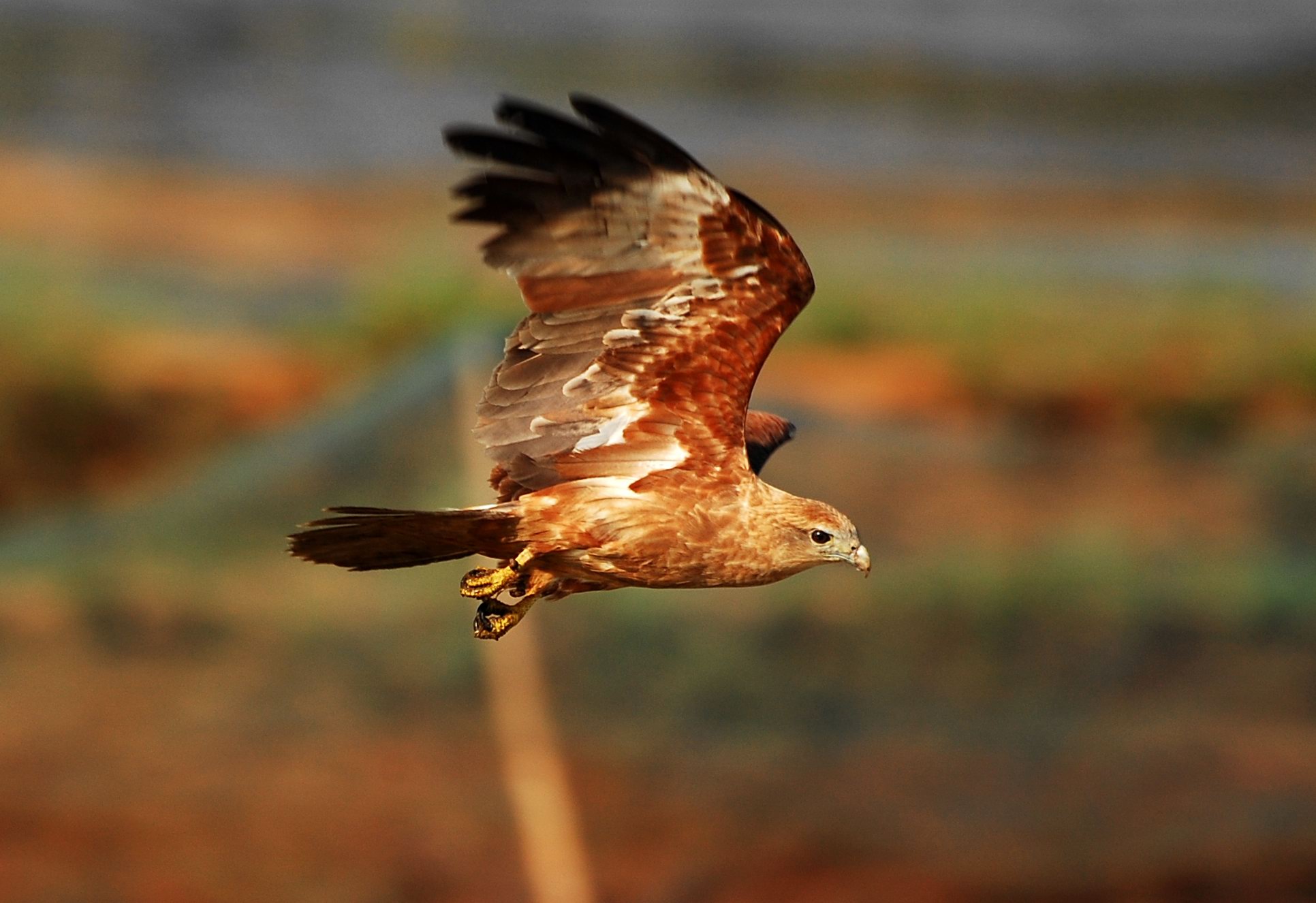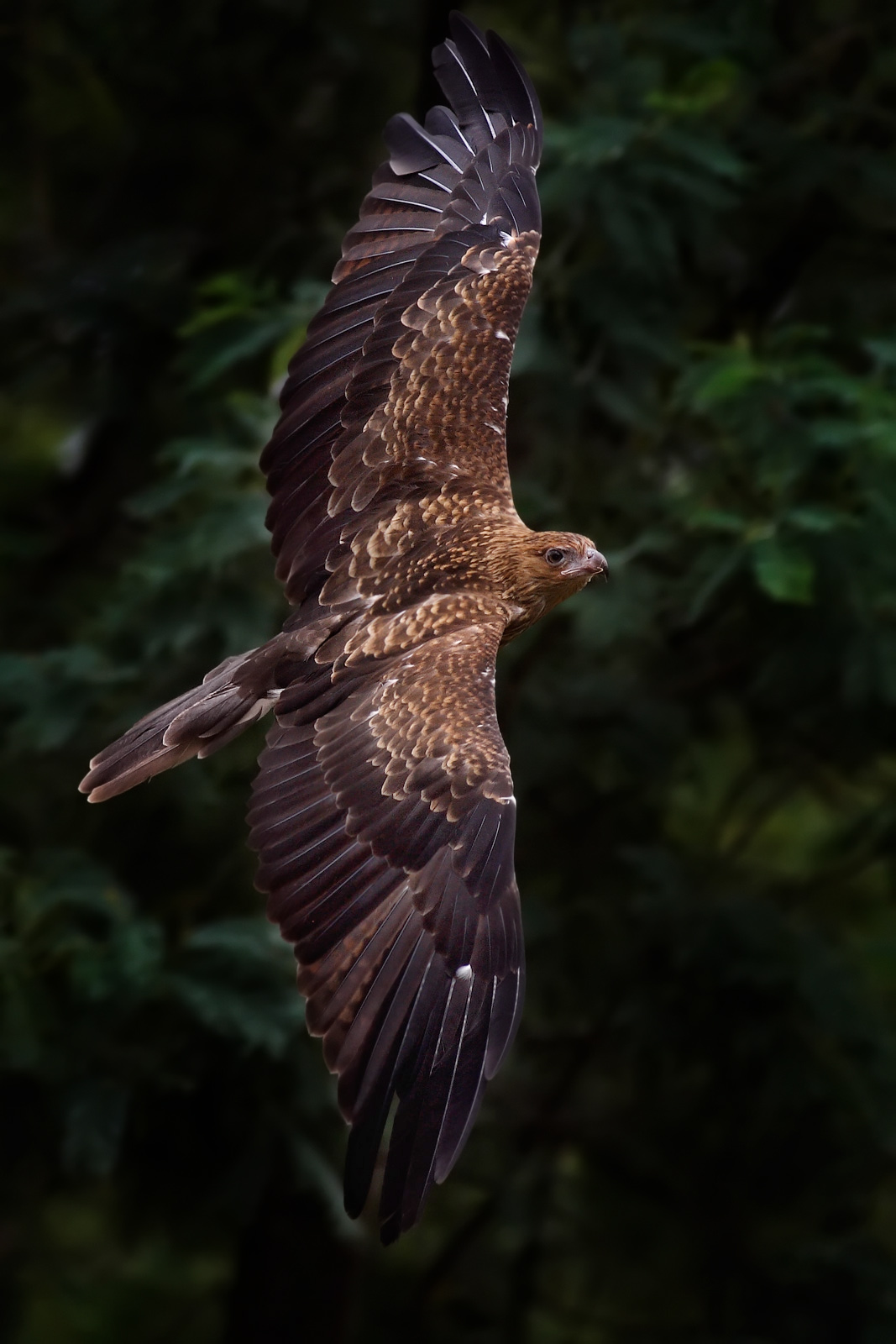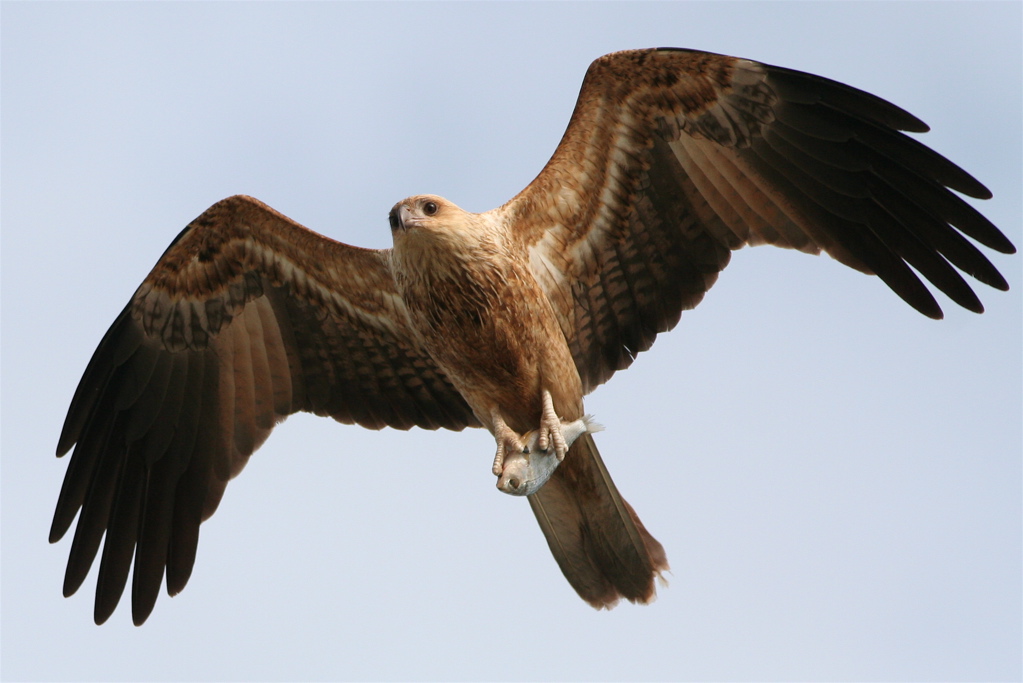|
Haliastur
''Haliastur'' is a genus of medium-sized diurnal birds of prey. It consists of two species of kites which form part of the subfamily Milvinae; some authorities place these species in the genus '' Milvus'', despite clear differences in behaviour, voice and plumage. The genus was erected by the English naturalist Prideaux John Selby in 1840 with brahminy kite (''Haliastur indus'') as the type species. The name of the genus combines the Ancient Greek ''hali-'' "sea-" and the Latin ''astur'' meaning "hawk". Description The two Haliastur species are medium-sized birds of prey with a strong, slightly squat rump, small head, relatively short and wide wings, a medium-long, rounded tail and short but strong legs and toes. The Whistling kite reaches a body length of 50 to 60 centimeters and has a wingspan of 120 to 145 centimeters. Males weigh an average of 700 grams, the females are significantly heavier at 850 grams. The Brahminy kite is a little smaller. Its body length is 44� ... [...More Info...] [...Related Items...] OR: [Wikipedia] [Google] [Baidu] |
Brahminy Kite
The brahminy kite (''Haliastur indus''), formerly known as the red-backed sea-eagle in Australia, is a medium-sized bird of prey in the family Accipitridae, which also includes many other diurnal raptors, such as eagles, buzzards, and harriers. They are found in the Indian subcontinent, Southeast Asia, and Australia. They are found mainly on the coast and in inland wetlands, where they feed on dead fish and other prey. Adults have a reddish-brown body plumage contrasting with their white head and breast which make them easy to distinguish from other birds of prey. Taxonomy In 1760, French zoologist Mathurin Jacques Brisson described and illustrated the Brahminy kite in the first volume of his ''Oiseaux'' based on a specimen collected in Pondicherry, India. He used the French name ''L'aigle de Pondichery''. The brahminy kite was included by the French polymath Georges-Louis Leclerc, Comte de Buffon in his ''Histoire Naturelle des Oiseaux''. It was also illustrated in a hand ... [...More Info...] [...Related Items...] OR: [Wikipedia] [Google] [Baidu] |
Brahminy Kite (16469397891)
The brahminy kite (''Haliastur indus''), formerly known as the red-backed sea-eagle in Australia, is a medium-sized bird of prey in the family Accipitridae, which also includes many other diurnal raptors, such as eagles, buzzards, and harriers. They are found in the Indian subcontinent, Southeast Asia, and Australia. They are found mainly on the coast and in inland wetlands, where they feed on dead fish and other prey. Adults have a reddish-brown body plumage contrasting with their white head and breast which make them easy to distinguish from other birds of prey. Taxonomy In 1760, French zoologist Mathurin Jacques Brisson described and illustrated the Brahminy kite in the first volume of his ''Oiseaux'' based on a specimen collected in Pondicherry, India. He used the French name ''L'aigle de Pondichery''. The brahminy kite was included by the French polymath Georges-Louis Leclerc, Comte de Buffon in his ''Histoire Naturelle des Oiseaux''. It was also illustrated in a hand-co ... [...More Info...] [...Related Items...] OR: [Wikipedia] [Google] [Baidu] |
Brahminy Kite
The brahminy kite (''Haliastur indus''), formerly known as the red-backed sea-eagle in Australia, is a medium-sized bird of prey in the family Accipitridae, which also includes many other diurnal raptors, such as eagles, buzzards, and harriers. They are found in the Indian subcontinent, Southeast Asia, and Australia. They are found mainly on the coast and in inland wetlands, where they feed on dead fish and other prey. Adults have a reddish-brown body plumage contrasting with their white head and breast which make them easy to distinguish from other birds of prey. Taxonomy In 1760, French zoologist Mathurin Jacques Brisson described and illustrated the Brahminy kite in the first volume of his ''Oiseaux'' based on a specimen collected in Pondicherry, India. He used the French name ''L'aigle de Pondichery''. The brahminy kite was included by the French polymath Georges-Louis Leclerc, Comte de Buffon in his ''Histoire Naturelle des Oiseaux''. It was also illustrated in a hand ... [...More Info...] [...Related Items...] OR: [Wikipedia] [Google] [Baidu] |
Whistling Kite
The whistling kite (''Haliastur sphenurus'') is a medium-sized diurnal raptor found throughout Australia (including coastal islands), New Caledonia and much of New Guinea (excluding the central mountains and the northwest). Also called the whistling eagle or whistling hawk, it is named for its loud whistling call, which it often gives in flight. Some authorities put this species in the genus '' Milvus'', despite marked differences in behaviour, voice and plumage between this species and other members of that genus. Description The whistling kite ranges in size from , with a wingspan between . Weights range from an average of for males and for females. As with most raptors, females are larger and heavier than males; though there is considerable overlap between the sexes, females can be up to 21% larger and 42% heavier. Southern birds are also larger than those found in the tropics. Male and female plumages are the same. Adult birds are a pale buff on the head ... [...More Info...] [...Related Items...] OR: [Wikipedia] [Google] [Baidu] |
Haliastur
''Haliastur'' is a genus of medium-sized diurnal birds of prey. It consists of two species of kites which form part of the subfamily Milvinae; some authorities place these species in the genus '' Milvus'', despite clear differences in behaviour, voice and plumage. The genus was erected by the English naturalist Prideaux John Selby in 1840 with brahminy kite (''Haliastur indus'') as the type species. The name of the genus combines the Ancient Greek ''hali-'' "sea-" and the Latin ''astur'' meaning "hawk". Description The two Haliastur species are medium-sized birds of prey with a strong, slightly squat rump, small head, relatively short and wide wings, a medium-long, rounded tail and short but strong legs and toes. The Whistling kite reaches a body length of 50 to 60 centimeters and has a wingspan of 120 to 145 centimeters. Males weigh an average of 700 grams, the females are significantly heavier at 850 grams. The Brahminy kite is a little smaller. Its body length is 44� ... [...More Info...] [...Related Items...] OR: [Wikipedia] [Google] [Baidu] |
Whistling Kite
The whistling kite (''Haliastur sphenurus'') is a medium-sized diurnal raptor found throughout Australia (including coastal islands), New Caledonia and much of New Guinea (excluding the central mountains and the northwest). Also called the whistling eagle or whistling hawk, it is named for its loud whistling call, which it often gives in flight. Some authorities put this species in the genus ''Milvus'', despite marked differences in behaviour, voice and plumage between this species and other members of that genus. Description The whistling kite ranges in size from , with a wingspan between . Weights range from an average of for males and for females. As with most raptors, females are larger and heavier than males; though there is considerable overlap between the sexes, females can be up to 21% larger and 42% heavier. Southern birds are also larger than those found in the tropics. Male and female plumages are the same. Adult birds are a pale buff on the head, br ... [...More Info...] [...Related Items...] OR: [Wikipedia] [Google] [Baidu] |
Kite (bird)
Kite () is the common name for certain birds of prey in the family Accipitridae, particularly in subfamilies Milvinae, [], and Perninae."kite". Encyclopædia Britannica. Encyclopædia Britannica Online. Encyclopædia Britannica Inc., 2014. Web. 24 Nov. 2014 . The term is derived from Old English ''cȳta'' (“kite; bittern”), from the Proto-Indo-European root *''gū- '', "screech." Some authors use the terms "hovering kite" and "soaring kite" to distinguish between ''Elanus'' and the milvine kites, respectively. The group may also be differentiated by size, referring to milvine kites as "large kites", and elanine kites as "small kites". Species * Subfamily Elanid kite, Elaninae ** Genus ''Elanus'' *** Black-winged kite, ''Elanus caeruleus'' *** Black-shouldered kite, ''Elanus axillaris'' *** White-tailed kite, ''Elanus leucurus'' *** Letter-winged kite, ''Elanus scriptus'' ** Genus ''Chelictinia'' *** Scissor-tailed kite, ''Chelictinia riocourii'' ** Genus ''Gampsonyx'' ** ... [...More Info...] [...Related Items...] OR: [Wikipedia] [Google] [Baidu] |
Kites (birds)
A kite is a tethered heavier-than-air or lighter-than-air craft with wing surfaces that react against the air to create lift and drag forces. A kite consists of wings, tethers and anchors. Kites often have a bridle and tail to guide the face of the kite so the wind can lift it. Some kite designs don’t need a bridle; box kites can have a single attachment point. A kite may have fixed or moving anchors that can balance the kite. The name is derived from kite, the hovering bird of prey. The lift that sustains the kite in flight is generated when air moves around the kite's surface, producing low pressure above and high pressure below the wings. The interaction with the wind also generates horizontal drag along the direction of the wind. The resultant force vector from the lift and drag force components is opposed by the tension of one or more of the lines or tethers to which the kite is attached. The anchor point of the kite line may be static or moving (e.g., the towing of a ... [...More Info...] [...Related Items...] OR: [Wikipedia] [Google] [Baidu] |
Bird Genera
Birds are a group of warm-blooded vertebrates constituting the class Aves (), characterised by feathers, toothless beaked jaws, the laying of hard-shelled eggs, a high metabolic rate, a four-chambered heart, and a strong yet lightweight skeleton. Birds live worldwide and range in size from the bee hummingbird to the ostrich. There are about ten thousand living species, more than half of which are passerine, or "perching" birds. Birds have whose development varies according to species; the only known groups without wings are the extinct moa and elephant birds. Wings, which are modified forelimbs, gave birds the ability to fly, although further evolution has led to the loss of flight in some birds, including ratites, penguins, and diverse endemic island species. The digestive and respiratory systems of birds are also uniquely adapted for flight. Some bird species of aquatic environments, particularly seabirds and some waterbirds, have further evolved for swimmi ... [...More Info...] [...Related Items...] OR: [Wikipedia] [Google] [Baidu] |
Whistling Kite In Flight Edit 1
Whistling without the use of an artificial whistle is achieved by creating a small opening with one's lips, usually after applying moisture (licking one's lips or placing water upon them) and then blowing or sucking air through the space. The air is moderated by the lips, curled tongue, teeth or fingers (placed over the mouth or in various areas between pursed lips) to create turbulence, and the curled tongue acts as a resonant chamber to enhance the resulting sound by acting as a type of Helmholtz resonator. By moving the various parts of the lips, fingers, tongue and epiglottis, one can then manipulate the types of whistles produced. Techniques Pucker whistling is the most common form in much Western music. Typically, the tongue tip is lowered, often placed behind the lower teeth, and pitch altered by varying the position of the tongue. Although varying the degree of pucker will change the pitch of a pucker whistle, expert pucker whistlers will generally only make small var ... [...More Info...] [...Related Items...] OR: [Wikipedia] [Google] [Baidu] |
Ancient Greek
Ancient Greek includes the forms of the Greek language used in ancient Greece and the ancient world from around 1500 BC to 300 BC. It is often roughly divided into the following periods: Mycenaean Greek (), Dark Ages (), the Archaic period (), and the Classical period (). Ancient Greek was the language of Homer and of fifth-century Athenian historians, playwrights, and philosophers. It has contributed many words to English vocabulary and has been a standard subject of study in educational institutions of the Western world since the Renaissance. This article primarily contains information about the Epic and Classical periods of the language. From the Hellenistic period (), Ancient Greek was followed by Koine Greek, which is regarded as a separate historical stage, although its earliest form closely resembles Attic Greek and its latest form approaches Medieval Greek. There were several regional dialects of Ancient Greek, of which Attic Greek developed into Koi ... [...More Info...] [...Related Items...] OR: [Wikipedia] [Google] [Baidu] |
.jpg)






.jpg)
